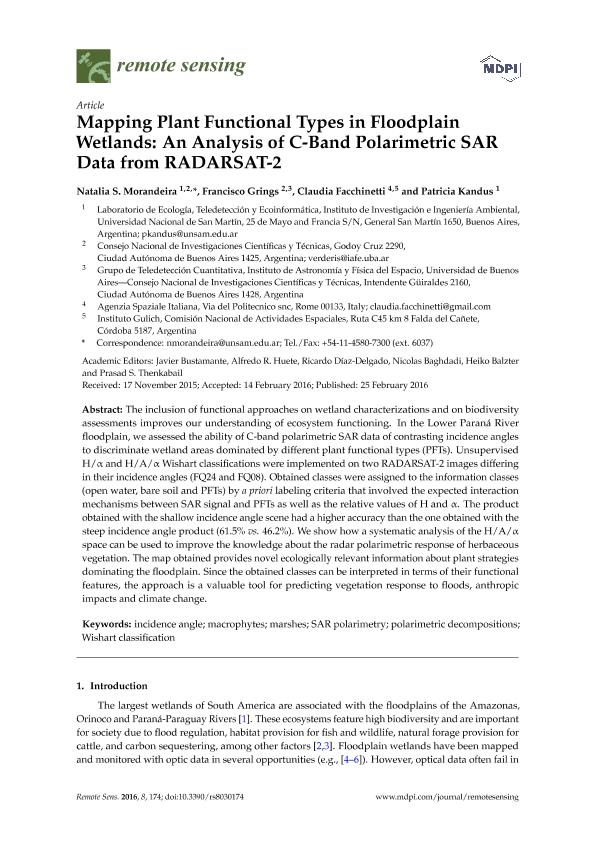Mostrar el registro sencillo del ítem
dc.contributor.author
Morandeira, Natalia Soledad

dc.contributor.author
Grings, Francisco Matias

dc.contributor.author
Faccinetti, Claudia
dc.contributor.author
Kandus, Patricia

dc.date.available
2017-07-28T17:39:53Z
dc.date.issued
2016-02
dc.identifier.citation
Morandeira, Natalia Soledad; Grings, Francisco Matias; Faccinetti, Claudia; Kandus, Patricia; Mapping Plant Functional Types in Floodplain Wetlands: An Analysis of C-Band Polarimetric SAR Data from RADARSAT-2; MDPI; Remote Sensing; 8; 3; 2-2016; 174,1-17
dc.identifier.issn
2072-4292
dc.identifier.uri
http://hdl.handle.net/11336/21519
dc.description.abstract
The inclusion of functional approaches on wetland characterizations and on biodiversity assessments improves our understanding of ecosystem functioning. In the Lower Paraná River floodplain, we assessed the ability of C-band polarimetric SAR data of contrasting incidence angles to discriminate wetland areas dominated by different plant functional types (PFTs). Unsupervised H/ and H/A/ Wishart classifications were implemented on two RADARSAT-2 images differing in their incidence angles (FQ24 and FQ08). Obtained classes were assigned to the information classes (open water, bare soil and PFTs) by a priori labeling criteria that involved the expected interaction mechanisms between SAR signal and PFTs as well as the relative values of H and . The product obtained with the shallow incidence angle scene had a higher accuracy than the one obtained with the steep incidence angle product (61.5% vs. 46.2%). We show how a systematic analysis of the H/A/ space can be used to improve the knowledge about the radar polarimetric response of herbaceous vegetation. The map obtained provides novel ecologically relevant information about plant strategies dominating the floodplain. Since the obtained classes can be interpreted in terms of their functional features, the approach is a valuable tool for predicting vegetation response to floods, anthropic impacts and climate change.
dc.format
application/pdf
dc.language.iso
eng
dc.publisher
MDPI
dc.rights
info:eu-repo/semantics/openAccess
dc.rights.uri
https://creativecommons.org/licenses/by-nc-sa/2.5/ar/
dc.subject
Macrophytes
dc.subject
Sar Polarimetry
dc.subject
Polarimetric Decompositions
dc.subject.classification
Ecología

dc.subject.classification
Ciencias Biológicas

dc.subject.classification
CIENCIAS NATURALES Y EXACTAS

dc.title
Mapping Plant Functional Types in Floodplain Wetlands: An Analysis of C-Band Polarimetric SAR Data from RADARSAT-2
dc.type
info:eu-repo/semantics/article
dc.type
info:ar-repo/semantics/artículo
dc.type
info:eu-repo/semantics/publishedVersion
dc.date.updated
2017-07-27T12:54:43Z
dc.journal.volume
8
dc.journal.number
3
dc.journal.pagination
174,1-17
dc.journal.pais
Suiza

dc.journal.ciudad
Ginebra
dc.description.fil
Fil: Morandeira, Natalia Soledad. Universidad Nacional de San Martín; Argentina
dc.description.fil
Fil: Grings, Francisco Matias. Consejo Nacional de Investigaciónes Científicas y Técnicas. Oficina de Coordinación Administrativa Ciudad Universitaria. Instituto de Astronomía y Física del Espacio. - Universidad de Buenos Aires. Facultad de Ciencias Exactas y Naturales. Instituto de Astronomía y Física del Espacio; Argentina
dc.description.fil
Fil: Faccinetti, Claudia. Agenzia Spaziale Italiana; Italia
dc.description.fil
Fil: Kandus, Patricia. Universidad Nacional de San Martín; Argentina
dc.journal.title
Remote Sensing
dc.relation.alternativeid
info:eu-repo/semantics/altIdentifier/url/http://www.mdpi.com/2072-4292/8/3/174
dc.relation.alternativeid
info:eu-repo/semantics/altIdentifier/doi/http://dx.doi.org/10.3390/rs8030174
Archivos asociados
